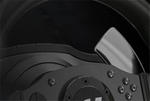
MICHELIN has announced that they developed a new wheel that will equip the NASA Moon Rover vehicles. The MICHELIN Lunar Wheel is made from special materials that are able to cope with the lunar conditions and terrain. The MICHELIN Lunar Wheel has been developed by the company's European and North American research centers and employs the use of special composite materials.
The MICHELIN Lunar Wheel is based on the TWEEL(R) assembly that helps maintain flexibility and constant ground contact pressure that enables moon rovers to travel over loose soil and lunar craters.
MICHELIN Press Release:
Michelin has developed a new lunar wheel for the next generation of NASA moon rover vehicles. The structurally supported tire and wheel assembly, made of breakthrough composite materials, was jointly developed at Michelin's European and North American research centers. This unique innovation will help Michelin meet NASA's mobility challenges for manned and un-manned moon missions planned for the coming decade.
"Michelin has partnered with NASA for more than 20 years to provide tires for the space shuttle, and now we are taking our involvement a step further in support of the next generation of space exploration," said David Stafford, chief operating officer of Michelin Americas Research Company. "This project demonstrates Michelin's ability to engineer advanced technology that meets the mobility needs of the world's most demanding customers, including NASA."
Based on the award-winning MICHELIN TWEEL(R) assembly, the MICHELIN Lunar Wheel maintains flexibility and constant ground contact pressure
that enables moon rovers to traverse loose soil and lunar craters. The MICHELIN Lunar Wheel has a low mass yet maintains a high load capacity that is 3.3 times more efficient than the original Apollo Lunar Rover wheels. The wheel structure, developed by Michelin, employs Michelin-patented composite materials. Its textile tread, developed in conjunction with Clemson University and Milliken & Company, enables moon rovers to maintain traction at very low temperatures.
"This new technology not only applies to lunar missions, but may also be directly leveraged into
other mobility applications requiring light-weight and low rolling resistance," said Stafford. "It's an exciting advance for mobility in space and here on Earth."
Funded in part by a grant from NASA's Innovative Partnership Program, the MICHELIN Lunar Wheel will be featured on the Scarab Rover, a lunar robot designed by Carnegie Mellon University, in cooperation with NASA's Exploration Technology Development Program for its In-Situ Resource Utilization project. Equipped with a drill designed to cut through layers of lunar soil, the Scarab Rover is capable of operating in continual darkness and extremely cold temperatures with little power. Michelin has also developed a lunar wheel for the ATHLETE Rover, a six-limbed lunar
rover capable of transporting cargo over any terrain to aid NASA in the assembly of the lunar outpost.
"Michelin's team of scientists and engineers worked closely with our design team to create a solution that addresses the unique challenges of lunar exploration," said Jaret B. Matthews, NASA's principal investigator for the development of the MICHELIN Lunar Wheel. "The MICHELIN Lunar Wheel successfully exceeds our initial design targets."
The MICHELIN Lunar Wheel will undergo field-testing on the Scarab Rover in Hawaii from Oct. 31 through Nov. 13, 2008 as part of a NASA Lunar Analogs testing and evaluation event. The terrain, rock distribution and soil materials of Hawaii's Big Island provide high-quality simulation of the lunar polar region.












